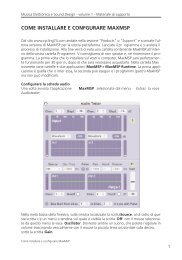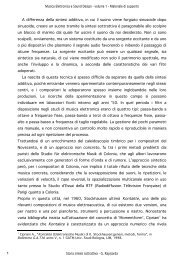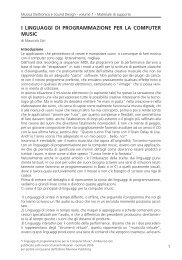programming with max/msp - Virtual Sound
programming with max/msp - Virtual Sound
programming with max/msp - Virtual Sound
You also want an ePaper? Increase the reach of your titles
YUMPU automatically turns print PDFs into web optimized ePapers that Google loves.
Chapter 3P - Noise generators, filters, and subtractive synthesis<br />
Note that the spectrum of pink noise, unlike white noise, is gradually<br />
attenuated as frequencies get higher, and that this attenuation (as we know<br />
from Section 3.1T) is 3 dB per octave.<br />
Reconstruct the simple patch shown in the figure and listen carefully to the<br />
difference between pink noise and white noise. Which of the two seems more<br />
pleasant (or maybe just less unpleasant), and why?<br />
Add an oscilloscope (scope~) to the two patches just built, remembering<br />
to set the “Calcount - samples per pixel” 3 attributes in the Value tab of the<br />
Inspector, and observe the difference between the waveforms of pink noise<br />
and white noise.<br />
In Figure 3.5, we see these two waveforms side-by-side.<br />
Fig. 3.5 Waveforms of white noise and pink noise<br />
Without bogging down in technical details, you can see that while white noise<br />
is basically a stream of random values, pink noise is generated using a more<br />
complex algorithm in which a sample, although randomly generated, cannot<br />
stray too far from the value of its predecessor. This results in the “serpentine”<br />
waveform that we see in the figure. The behavior of the two waveforms demonstrates<br />
their spectral content: when the difference between one sample and<br />
the next is larger, the energy of the higher frequencies in the signal is greater. 4<br />
As you know, white noise has more energy at higher frequencies than pink<br />
noise.<br />
Another interesting generator is rand~, which generates random samples<br />
at a selectable frequency and connects these values using line segments (as<br />
shown in Figure 3.6). Unlike noise~ and pink~, which each generate random<br />
samples on every tick of the DSP “engine” (producing a quantity of samples<br />
in one second that is equal to the sampling rate), <strong>with</strong> rand~ it is possible to<br />
choose the frequency at which random samples are generated, and to make<br />
the transition between one sample value and the next gradual, thanks to linear<br />
interpolation.<br />
3 We explained this attribute in Section 1.2P.<br />
4 To understand this assertion, notice that the waveform of a high sound oscillates quickly, while<br />
that of a low sound oscillates slowly. At equal amplitudes, the difference between succeeding<br />
samples for the high frequency case will be larger, on average, than for the low frequency case.<br />
from “Electronic Music and <strong>Sound</strong> Design” Vol. 1 by Alessandro Cipriani and Maurizio Giri<br />
© ConTempoNet 2010 - All rights reserved<br />
3P<br />
359







